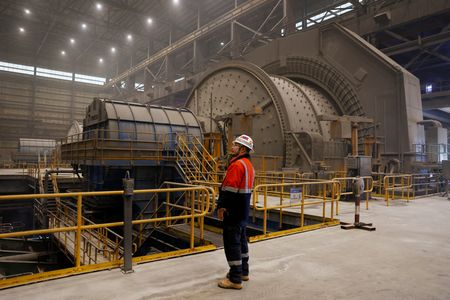By Melanie Burton
MELBOURNE (Reuters) – Global mining giant Rio Tinto, which sparked outrage after destroying an ancient Indigenous site in Australia in 2020, faces new pressure from socially conscious investors and lenders, this time on water practices at two of its mines.
A group representing UK pension funds, Local Authority Pension Fund Forum (LAPFF), has raised concerns about the company’s water management at its Oyu Tolgoi copper mine in Mongolia and an ilmenite mine in Madagascar.
It’s a burr in the saddle for CEO Jakob Stausholm, who was brought in to restore the company’s social license after it blew up an Aboriginal rock shelter at Juukan Gorge.
Questions around Rio Tinto’s environmental credentials could complicate its efforts to secure government approvals to build a lithium mine in Serbia and dig a giant copper mine in Arizona, both projects long delayed by local protests.
“Rio Tinto already has significant reputational risk stemming from Juukan Gorge, so its water challenges in Madagascar and Mongolia (as two pressing examples) pose a huge threat of further reputational damage,” LAPFF Chair Doug McMurdo told Reuters.
Given growing incidents of litigation around water management globally and tougher regulations coming into place, these challenges are also a highly financially material issue, he said.
Rio Tinto said it recognised the importance of water to its host communities and that it was “committed to driving effective water stewardship and enhanced transparency for stakeholders.”
LAPFF, whose members hold more than GPB 350 billion ($445 billion) in UK pension funds, has been trying to build support for a resolution that would press Rio Tinto to undertake independent water impact assessments at its mine sites.
“There is a sense that companies have been greenwashing and that they need to face a reckoning. Shareholder resolutions are a good way to bring that reckoning,” McMurdo said, speaking about companies in general. Water practices in the mining industry were of particular concern, he said.
Rio Tinto was graded an “F” by environmental adviser CDP for failing to disclose its water data to the group since 2016. Other major miners, too, have been given fail ratings for non-disclosure.
TAILINGS SEEPAGE
LAPFF circulated an investor briefing late last year that said Oyu Tolgoi’s copper operations have affected ground water quality outside the mine lease and questioned whether its tailings dam was watertight.
Civil society group Accountability Counsel, which works with Mongolian herders, told Reuters that some livestock became ill and died after mine operations began, which herders blame on worsening water quality.
Their concerns have not been adequately addressed by Rio Tinto, it said.
Rio Tinto said Oyu Tolgoi has a rigorous water monitoring programme in place and results were consistently shared with communities, lenders, regulators and in public reports. It said it is taking action to fix the seepage.
“The seepage has not impacted the water quality of herder wells or of any users to any extent as confirmed by monitoring data,” Oyu Tolgoi said in a November 2023 report.
Reuters was unable to quantify the number of livestock affected or whether they died as a result of poor water quality.
However, the seepage which has been ongoing since 2018 has been declared an environmental incident by the project’s lenders, which include the European Bank for Reconstruction and Development (EBRD), Oyu Tolgoi said in a report in November.
That requires the Oyu Tolgoi mine to undertake a remedial action plan.
To be sure, lenders are unlikely to pull funding for the $7 billion project, but given the precious nature of water in the arid region, EBRD spokesman Anton Usov said the bank is closely monitoring Rio’s remedial action plan.
“Lenders have to ensure that OT is held accountable for its failure to comply with lenders’ environmental and social framework,” said Julio Castor Achmadi, communities associate of Accountability Counsel.
In Madagascar, a local advocacy group says tailings dam failures in 2010, 2018 and 2022 at Rio’s QIT Madagascar Minerals (QMM) ilmenite mine, which produces titanium dioxide for paints, have worsened water quality, contributed to fish deaths and spurred conflict in the Anosy region.
The Andrew Lees Trust is pushing for “independent audits … in order to provide the transparency and accountability required to resolve the current QMM challenges and meet international standards.”
Rio Tinto said it had compensated local fisherfolk, that an independent report it commissioned found no conclusive link between its mine activities and observed dead fish, and it has supported local leaders and authorities to resolve unrest.
INDEPENDENT REPORTS QUESTIONED
In both locations, LAPFF and advocacy groups say Rio Tinto’s water audits don’t give the full picture of the impact of its operations.
Critics of Rio’s planned mines in Serbia and Arizona say they are also worried about the company’s practices, according to the investor briefing.
The pension fund group decided to hold off filing its proposed resolution until April 2025 after Rio Tinto engaged with it and acknowledged in a December report that it could do better at its Madagascar site.
In the Madagascar report, Rio Tinto said it recognised greater transparency and equity around its water management was required.
“We must address these concerns,” Rio Tinto said.
($1 = 0.7868 pounds)
(Reporting by Melanie Burton; Additional reporting by Simon Jessop; Editing by Sonali Paul)













